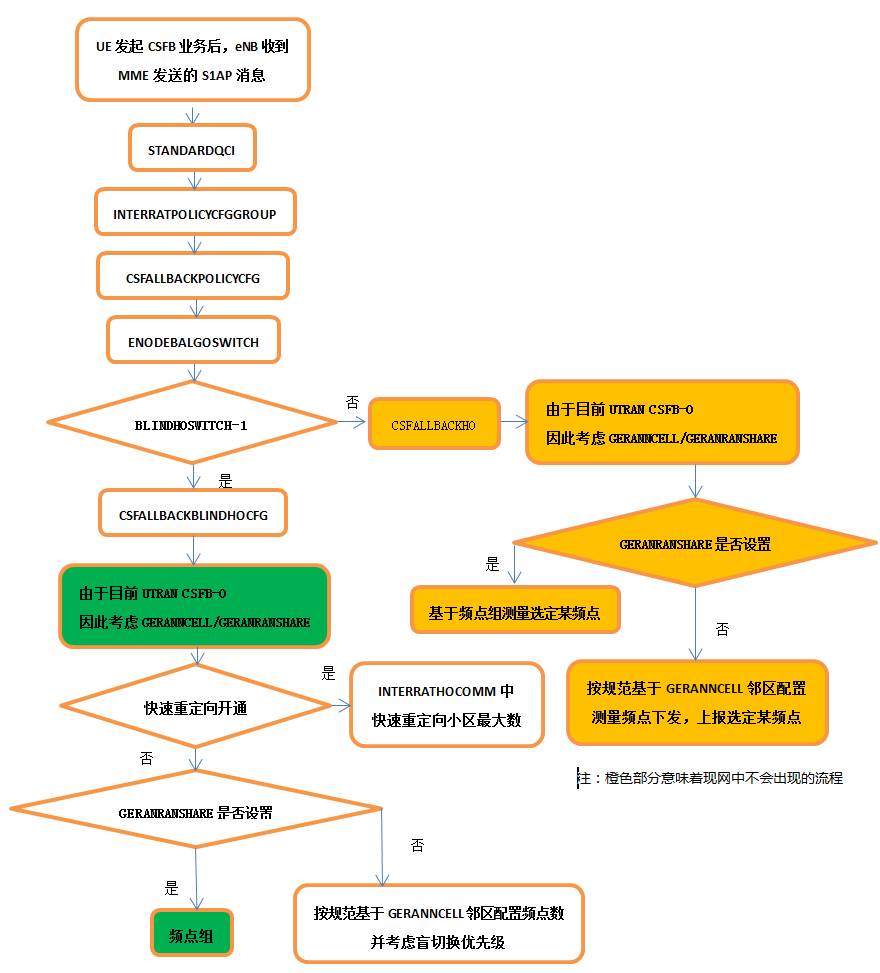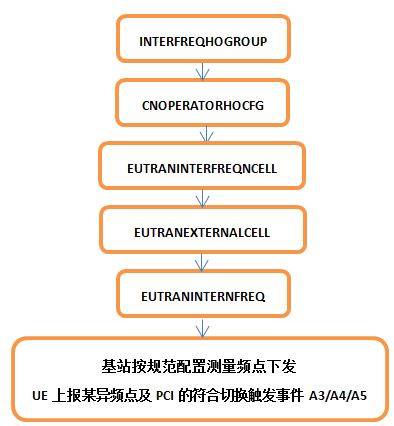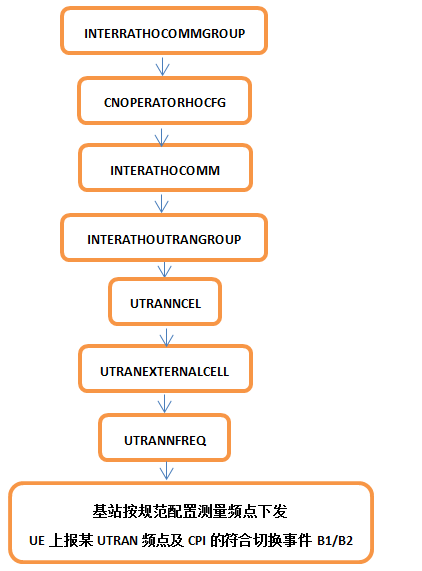This article focuses on specific business aspects identified by QCI, such as base station-level QCI settings or cell-level QCI settings. This can lead to different QCI business switching parameter group IDs, DRX parameter group IDs, inter-system policy configuration group IDs, RLC PDCP parameter group IDs, logical channel priorities, etc.
This article only introduces relevant commands; single node commands such as cell selection, reselection, base station functions, and cell algorithm function settings are not covered here.
1 Commands Involved in CSFB Business
The UE initiates a NAS data service request (non-signaling), such as service requests or extended service requests. After the NAS service is approved by the MME, the MME carries ERAB and QoS parameters (including QCI and ARP, where ARP further includes priority, preemption capability, preemption vulnerability, etc.) in the initial context setup request or UE context modification request at the S1 interface.
Once the base station receives such S1AP messages, it first performs standard QCI matching. The relevant base station command is STANDARDQCI (cell-level and base station-level). This command involves intra-EUTRAN business or inter-system business, and at the cell level, it pertains to same-frequency and different-frequency switching parameter group IDs, inter-system switching parameter group IDs, etc.
At the base station level, in cases that may involve inter-system business, the standard QCI configuration must also include the inter-system policy configuration group ID as a related item, linking to the inter-system policy configuration group INTERRATPOLICYCFGGROUP that contains related item IDs. This command involves the specific methods available for business transitioning from EUTRAN to inter-system UTRAN/GERAN/CDMA2000, such as PSHO/SRVCC/Redirect/CCO(NACC). Even within the same inter-system policy configuration group, the settings for similar switches may differ for different inter-systems. For example, UTRAN PSHO may be enabled while GERAN GPRS EDGE PSHO is disabled. Additionally, two points must be clarified:
Firstly, for instance, the current VoLTE service in the live network is bound to SRVCC technology; thus, SRVCC is enabled in the corresponding inter-system policy configuration group ID, while the corresponding redirection should be disabled;
Secondly, for example, in the inter-system policy configuration group ID corresponding to non-VoLTE services, SRVCC is disabled, while redirection is enabled.
For CSFB business, in addition to considering the above factors, it is also necessary to further consider the specific methods for implementing CSFB business, such as PSHO/CCO/Redirect methods, which are defined by the CSFB policy configuration. The command is CSFALLBACKPOLICYCFG, which can be defined separately for connected and idle states, thus jointly deciding the fallback methods applicable to CSFB business. This command is aimed at setting the CSFB layering switch in the base station algorithm switch, distinguishing between idle and connected states when enabled. If not enabled, it refers to the connected state setting. Regardless, based on the current CSFB policy configuration data, whether in connected or idle state CSFB, these switches are all enabled: “CSFB Redirection switching method switch: on, CSFB CCO switching method switch: on, CSFB PSHO switching method switch: on”.
Ultimately, what method CSFB business can adopt must also consider whether related items in the base station algorithm switch are enabled. The command corresponding to the base station algorithm switch is ENODEBALGOSWITCH, first determining which network will bear the CSFB business, whether it is UTRAN or GERAN, or both systems (this setting is unlikely, but logically, it must be considered what process would be triggered if such a setting were made), and whether the switch for implementing the business method is enabled, such as UTRAN PSHO/Redirect or GERAN PSHO/Redirect/CCO(NACC).
To better describe this functionality, the common settings in China Mobile’s live network base station algorithm switch are UTRAN CSFB-0/GERAN CSFB-1, UTRAN PSHO-0/GERAN PSHO-0, UTRAN Redirect-1/GERAN Redirect-1, GERAN CCO-0, GERAN NACC-0. Based on the above parameter configuration, it indicates that CSFB business is based on GERAN redirection method. Furthermore, regardless of whether UTRAN or GERAN, the PS domain switching is disabled (the prerequisite for PSHO switching is that the target base station must prepare switching resources. Since the operator has not upgraded the inter-system RNC/NODEB or BSC/BTS, true PS switching cannot be realized and can only be done through redirection).
We know that CSFB redirection can be realized by both measurement-based redirection and blind redirection. This depends on whether the switch involving CSFB blind switching in the base station algorithm switch is enabled, i.e., the value of the parameter BLINDHOSWITCH. The current network configuration is in the enabled state (BLINDHOSWITCH-1). It is important to emphasize that this parameter only pertains to whether CSFB can be blind switched, not involving other business blind switching methods. In Huawei’s WebLMT documentation, it is stated (Blind switching switch: when the blind switching switch is ON, it indicates that CSFB blind switching can be performed; when the blind switching switch is OFF, CSFB blind switching cannot be performed). This parameter should also be understood as the blind “fallback SWITCH” for CSFB business, meaning the CSFB implementation methods can be PSHO, CCO, or redirection, just not activating based on measurements to decide to select cells or frequency points or frequency point groups. Based on the relevant parameter settings, it can be seen that the current CSFB business is implemented through blind redirection.
If the CSFB blind switching switch is disabled, then CSFB business must be based on measurements, following the UTRAN/GERAN B1 event rules in the command CSFALLBACKHO. The measured frequency points can be based on the neighboring cell configuration’s selected frequency points. The CSFB UTRAN B1 event RSCP trigger threshold is -106dBm, and the CSFB GERAN B1 event RSSI trigger threshold is -103dBm. Only frequency points meeting these requirements can become CSFB fallback frequency points. Additionally, GERAN has another option, which is based on frequency point groups under the GERANRANSHARE function being enabled. Regardless of the method, the number of measurement objects (frequency points) that can be carried in the one-time measurement configuration must be considered.
It is worth noting that the current CSFB blind switching switch is enabled and must be enabled (unless not set or set incorrectly), meaning that the CSFB business process does not adopt a measurement-based approach. This process design is based on the consideration of call delay; experimental network verification tests have shown that if CSFB adopts a measurement-based redirection, it would increase the delay by more than 3 seconds, which would cause user experience perception issues. If the S1 interface protocol version adopts R9, it can enable the RIM-based CCO with NACC technology, that is, the fast CSFB function, which can shorten the CSFB fallback delay, though it also requires upgrades to inter-system SGSN/RNC/BSC network elements.
If the aforementioned business involves scenarios that can be conducted by both UTRAN and GERAN, for example, the base station algorithm setting UTRAN CSFB-1/GERAN CSFB-1 introduces the issue of different inter-system priority judgments; otherwise, it would cause confusion, specifically managed by the blind switching inter-system configuration command CSFALLBACKBLINDHOCFG. It should be noted that this command should not be interpreted literally as being set only for CSFB business; it actually involves all blind switching businesses, including both CSFB business and data services (the second part of this article describes blind switching for data transmission). Additionally, the “HO” mentioned in this command specifically refers to switching policy, which is better understood as “SWITCH”, meaning fallback for inter-system business, including PSHO, CCO, redirection, SRVCC, and other specific implementation methods must follow inter-system priority. Of course, if the live network base station algorithm switch only enables redirection, then this command also specifies the blind redirection inter-system priority, involving both CSFB business and data transmission business. The priority setting for any inter-system business can either be UTRAN priority or GERAN priority, with the settings referring to China Mobile’s specifications. Using Huawei’s network management, inter-system switching statistics can be collected, including various inter-system business implementation methods.
Due to the large number of commands and related parameters involved in inter-system, the following will first elaborate on the details and then draw a flowchart overall. For inter-system blind switching business: CSFB business is divided into idle state or connected state situations, while data business only involves connected state situations. The current network’s inter-system switching technology has only enabled the redirection switch, so the blind switching method is blind redirection. The commands with the highest priority inter-system/second highest priority inter-system/lowest priority inter-system are for all business in connected state, including when the UE initiates a calling CSFB business or receives a called CSFB business notification, while the CSFB IDLE state first priority target RAT, CSFB IDLE state second priority target RAT, and CSFB IDLE state third priority target RAT only pertain to the idle state CSFB business.
Given that the current settings in China Mobile’s live network base station algorithm have been fixed at UTRAN CSFB-0/GERAN CSFB-1, meaning the UTRAN CSFB switch has been disabled, therefore, in blind switching inter-system configuration, whether in connected state or idle state CSFB business, any priority in the GERAN system configuration is acceptable. Since various settings may occur in the CSFB business process, to simplify various setting conditions, the command flow involved in CSFB business is organized as follows:
 (Click to view the full image)
(Click to view the full image)
For CSFB business, the rapid redirection function must also be considered, as enabling this function will alter the logical structure, described as follows:
For enabling the rapid redirection function for Flash CSFB (R9 redirection based on RIM, which cannot be implemented on the original R8 version of the S1 interface), it is necessary to enable GeranFlashCsfbSwitch, GeranFlashRedirectSwitch, GERAN_RIM_SWITCH, as the parameters with yellow backgrounds in the following command need to be modified to -1. The original command is as follows:
MODENODEBALGOSWITCH:HOALGOSWITCH=GeranCsfbSwitch-1&GeranFlashCsfbSwitch-0,HOMODESWITCH=GeranRedirectSwitch-1&BlindHoSwitch-1,REDIRECTSWITCH=GeranFlashRedirectSwitch-0,RIMSWITCH=GERAN_RIM_SWITCH-0; Additionally, the protocol version supported by the S1 interface needs to be adjusted to R9, commanded by: MOD S1INTERFACE: S1InterfaceId=0, MmeRelease=Release_R9;
2 Commands Involved in Data Business Blind Switching (Blind Redirection)
The command CELLHOPARACFG only includes inter-frequency inter-system blind switching A2 thresholds, such as the inter-frequency inter-system blind switching A1A2 event RSRP threshold of -122dBm. In this context, blind switching should be understood as blind “fallback SWITCH”, that is, business fallback, as a switching policy. Specific implementations can include switching, PSHO, CCO, redirection, etc., but using redirection or CCO will increase interruption delay.
The reason this command is referred to as inter-frequency inter-system blind switching is that both inter-frequency and inter-system can realize blind switching, implying that prior to business fallback, it is not based on measurements. The priority or switch is determined by the emergency inter-frequency blind switching switch setting in the base station algorithm commands: EmcInterFreqBlindHoSwitch (emergency inter-frequency blind switching switch). When the emergency inter-frequency blind switching switch is ON, during emergency blind switching triggering, priority will be given to redirecting to inter-frequency frequency points; when the emergency inter-frequency blind switching switch is OFF, during emergency blind switching triggering, it will only switch to inter-system frequency points. Another parameter: the emergency blind switching A1 switch has the following meaning: when the emergency blind switching A1 switch is ON, it starts blind switching A1 measurements. In cases where there is a conflict between the blind switching measurement event and the switching process, after the switching process completes, it controls the start of emergency blind switching; when the emergency blind switching A1 switch is OFF, it does not initiate blind switching A1 measurements. In cases where there is a conflict between the blind switching event and the switching process, it does not trigger emergency blind switching. In summary, if the two parameters in the current network base station algorithm switch are both closed, then blind switching will be directed towards the inter-system, and after reporting the blind switching A2, it will not report A1 again (as there is no blind switching A1 in the measurement configuration sent out), which also conforms to the emergency situation of inter-system blind switching. The following will elaborate on the process.
After the RRC security mode is completed, the measurement configuration sent out will include this A2 threshold measurement identifier tuple (MeasID-MeasObjID-MeasRptID). When conducting data business connection in the LTE system, once the serving cell RSRP drops below this threshold, it will trigger this A2 event report.
Next, consider the implementation methods of business switching in the base station algorithm switch, such as PSHO/Redirect/CCO(NACC). The current parameter settings are UTRAN PSHO-0/GERAN PSHO-0, UTRAN Redirect-1/GERAN Redirect-1, GERAN CCO-0/GERAN NACC-0, meaning only the redirection method is considered. It is worth noting that both UTRAN and GERAN are capable of blind redirection in the settings, so it is necessary to conduct a blind switching inter-system priority selection, involving the command CSFALLBACKBLINDHOCFG (described in the second part of this article). Currently, China Mobile’s parameter configuration has the highest priority inter-system as GERAN, the second highest priority inter-system as UTRAN, and the lowest priority inter-system as CDMA2000. Based on the above parameter settings, blind switching is implemented via GERAN’s blind redirection method. The blind redirection frequency points can either be based on neighboring cell frequency point selections (considering the neighboring cell’s blind switching priority, it is recommended not to set it to 0, otherwise, it will lead to blind redirection triggered by the connected state frequency priority) or provided in frequency point group manner. The difference between these two lies in whether the frequency point group operator sharing information GERANRANSHARE is set.
How to improve user experience in weak LTE coverage scenarios has always been a key focus of network work, especially since the current depth of LTE network coverage is less than that of UTRAN and GERAN. Next, we will discuss the implementation methods and significance of early network enabling blind switching to UTRAN. Although the current network no longer operates this way, it does not affect our understanding of this thought: assuming that before LTE blind switching (blind redirection), there would be a switching (redirection) based on UTRAN measurement A2 event report. Considering that some phones, such as the iPhone 5s, do not support simultaneous measurements for UTRAN while conducting business on the LTE network, in scenarios with poor LTE signals, this step may be skipped, leading to the occurrence of blind switching (blind redirection). Generally, LTE will blind switch (blind redirection) to GERAN, which has a slower data rate, resulting in a poor user experience.
It is well known that the data business experience in UTRAN is better than in GERAN. It may be considered to enable LTE blind redirection to UTRAN when UTRAN coverage is good, which is merely a simple command:
MOD CSFALLBACKBLINDHOCFG: CnOperatorId=0, InterRatHighestPri=UTRAN, InterRatSecondPri=GERAN;
This means that when the LTE terminal is in data business connection state, once the blind switching condition A2 value is triggered, after reporting the A2 measurement report, the base station will preferentially select the highest priority UTRAN system for blind switching, and then in that system, prioritize selecting the neighboring cell with the highest blind switching priority. If the final decision is to adopt the blind redirection method, the highest priority blind switching neighboring cell’s corresponding frequency point will be selected as the blind redirection target frequency point. If there is no neighboring cell configured or all neighboring cells’ blind switching priorities are 0, it means that no blind switching neighboring cells can be found. In this case, the redirection target frequency point will be determined based on the connected state frequency priority, and then the blind redirection process will be executed directly.
The general process for determining inter-frequency blind switching or determining a certain inter-system is as follows:

Note: This flowchart ultimately follows the LTE in-network switching process, including switching preparation, execution, and completion.
Organizing the inter-frequency switching command flow as follows:

Note: This flowchart ultimately follows the inter-system switching process. Currently, the redirection method is adopted. Since the command CNOPERATORHOCFG in the live network generally adopts UTRAN A2 RSRP threshold bias(dBm)=0dBm/GERAN A2 RSRP threshold bias(dBm)=-100dBm settings, this chart does not include cases based on GERAN measurement.
Currently, because the eSRVCC function is enabled, the GERAN measurement is enabled while UTRAN measurement is disabled, so the UTRAN text in the above flowchart can be replaced by GERAN.
Writing original documents is exceptionally challenging and requires great effort. If this article helps you understand Huawei LTE operation commands, please consider giving a “thumbs up” as encouragement via the “appreciation” button shown below.
Author Introduction: Zhou Guoyou, after working in the core network, transitioned to wireless network optimization, familiar with 3GPP protocols, signaling processes, proficient in 2G, 3G, and 4G interoperability and optimization, currently at Hangzhou Huaxing Company.
Network optimization freelance submission email: [email protected]
Long press the QR code to follow
